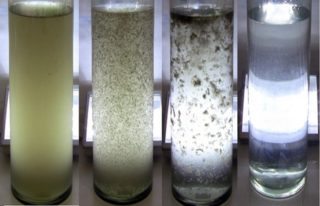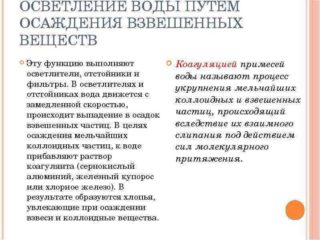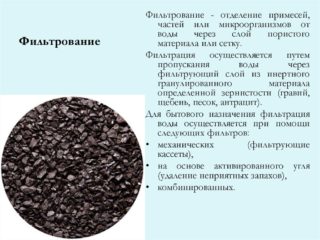Clarification of water is the process of removing suspended and colloidal substances consisting of clay, sandy or silty particles. Their presence worsens the quality of water, makes it cloudy and unusable for both drinking and technical purposes.
Water clarification methods

In the technological scheme of purification, clarification occurs first. Its essence lies in the removal of impurities by gravity or by means of forced filtration.
Water clarification methods:
- settling in sedimentation tanks;
- clarification in hydrocyclones;
- coagulation and flotation;
- filtration through a layer of suspended sediment or filter material;
- use of oxidants in the field.
The choice of the clarification method is one of the main points in the development of the purification technology, since it will affect the entire process of water treatment in the future. You need to carefully approach this task and study the nuances of each option.
Settling method
The method consists in removing suspended and colloidal particles by gravity. The deposition rate depends on their shape, size, density, roughness and on the temperature of the liquid. Optimal values for this process are 8-12 ° C.
One of the conditions for effective treatment is the speed of water movement in the sump, which directly affects the precipitation of particles. It should be in the range of 0.12-0.6 mm / s, depending on the structure of the structure.
Sump tanks are used: horizontal, vertical and radial. Each of them is designed for certain values of the volume and amount of contamination.
The settling method is the simplest, the efficiency is 60-70%. The main disadvantage is the large volume of structures.
Clarification in hydrocyclones
The principle of operation of hydrocyclones is based on the separation of solid particles in a rotating fluid flow. Due to the tangential velocity, large impurities are pressed against the wall of the structure and are removed by gravity.
Coagulation and flotation
Efficiency depends not only on the amount of contamination, but also on the dose of coagulant, mixing speed, alkalinity. To intensify this process, it is necessary to use flocculants, which accelerate the agglomeration of flakes.
When clarifying with the use of coagulants, as a rule, a bleaching process occurs - the removal of humic substances, which give the water a yellowish, brown or green color. This often happens in stagnant areas such as swimming pools.
Filtration through a layer of suspended sediment
The method is a combination of filtration and the use of reagents to speed up the cleaning process. Coagulant flakes, interacting with colloidal substances, are retained by a layer of suspended sediment, due to which clarification occurs.
This method is suitable for heavily polluted waters, since a high cleaning effect can be obtained by spending a minimum amount of reagents.
Filtration through the loading layer
According to the speed of movement and cleaning time, fast and slow filters are distinguished. Slow ones are suitable for the purification of non-coagulated water containing relatively small impurities. Since this method is reagentless, the maximum values of the initial turbidity should be up to 50 mg / l, color up to 50 degrees. The speed of movement in such a filter is 0.1-0.3 m / h.
Fast filters are used to clarify turbid and colored waters. In the technological scheme of purification, fast filters are provided after the coagulation and sedimentation facilities, since it is impossible to obtain the desired effect in one step. It is important to periodically backwash the load to prevent subsequent contamination. The speed of movement in the fast filter is 5.5-15 m / h.
To purify water in the field, you can resort to household oxidants: hydrogen peroxide, brilliant green or whiteness. Their principle of action is no different from special coagulants, they do an excellent job with polluted waters of rivers and lakes.










